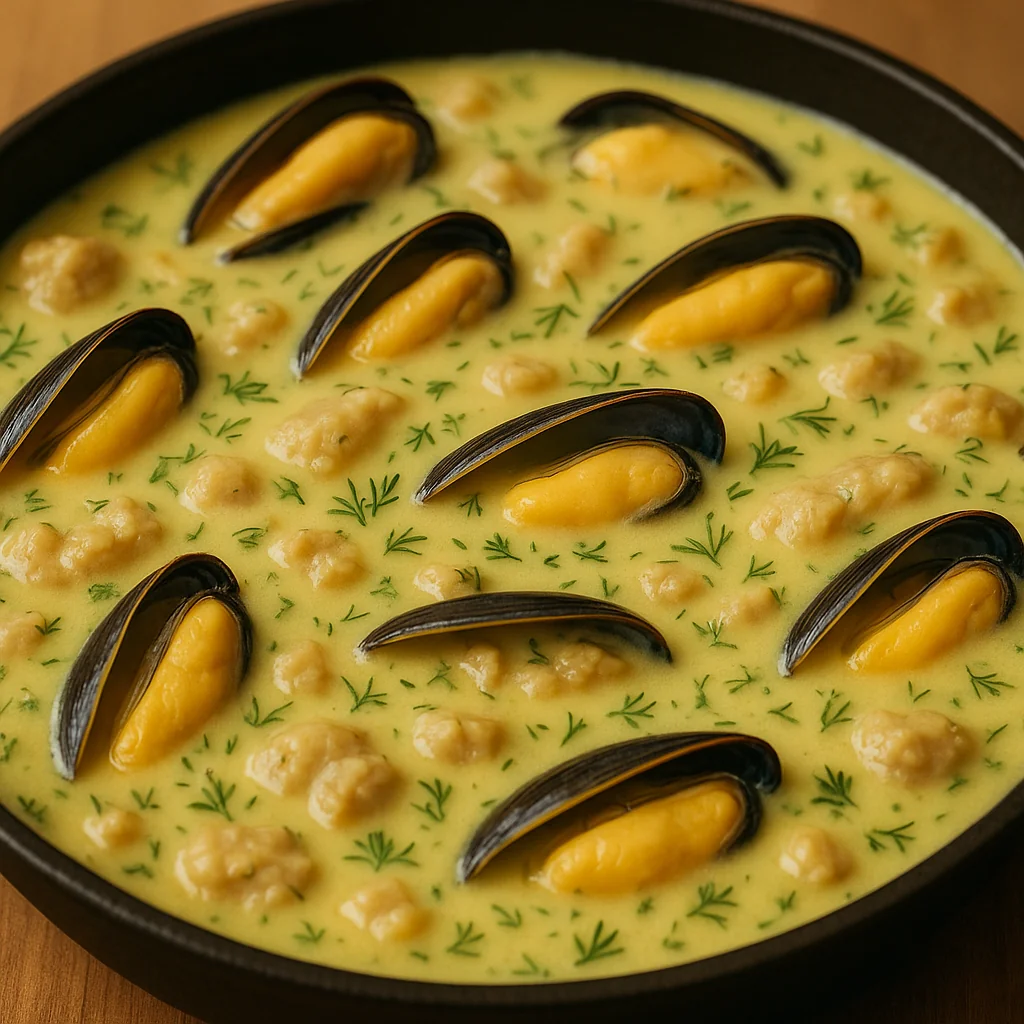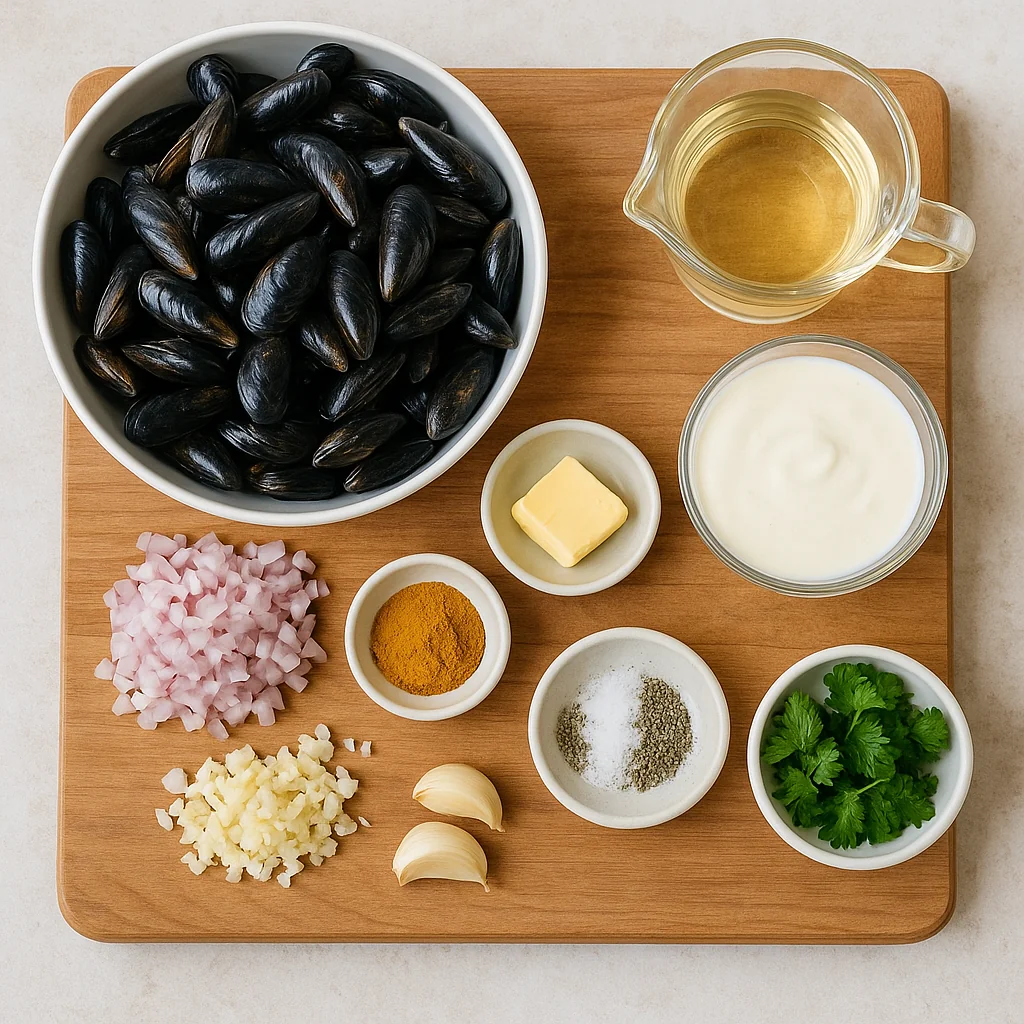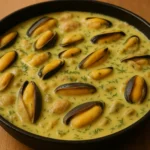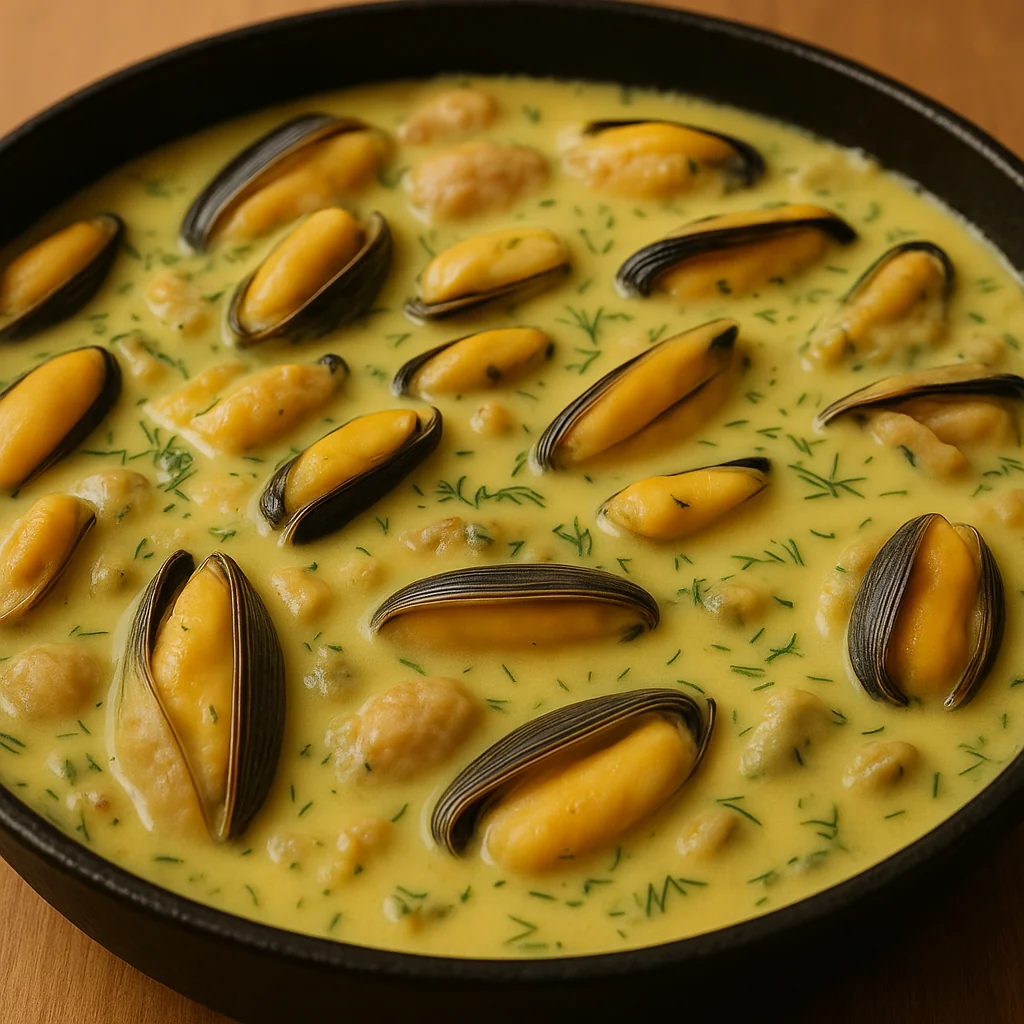Imagine a bowl of plump, juicy mussels, each one bathed in a velvety, saffron-hued cream sauce that’s so good you’ll want to drink it with a straw. That, my friends, is the magic of Mouclade Charentaise. This recipe is a journey to the French Atlantic coast in a single bite—creamy, fragrant, and utterly addictive. I first discovered this gem not in a fancy Parisian bistro, but in a small, family-run restaurant in La Rochelle, where the sea breeze mingled with the scent of garlic and wine. The owner told me it was his grandmother’s recipe, a dish made with love to welcome sailors home.
This Mouclade Charentaise recipe is incredibly special because it delivers a five-star restaurant experience with minimal effort. It looks elegant and complex, but you’ll be shocked to learn it comes together in under 30 minutes, making it perfect for a busy weeknight when you crave something special. It’s also a surprisingly family-friendly dish; kids absolutely love the hands-on fun of plucking the mussels from their shells. If you enjoyed the rich, comforting depth of our Classic French Onion Soup, you will fall head over heels for the sophisticated yet simple charm of this coastal classic. Get ready to impress your family and friends—and yourself!—with a dish that’s as delightful to make as it is to eat.
Table of Contents
Table of Contents
What is Mouclade Charentaise?
So, what on earth is a “Mouclade”? It sounds rather grand and mysterious, doesn’t it? Is it a secret code for the world’s most delicious mussels? A fancy culinary technique taught only in the hallowed halls of French gastronomy? The truth, humorously, is much simpler. The name “Mouclade” comes from the local dialect of the Charente region, where “moucle” is the word for mussel. So, a Mouclade is, quite literally, a dish of mussels! It’s a classic case of calling it what it is, with a little regional flair.
They say the way to a person’s heart is through their stomach, and this dish is a testament to that. It’s a humble name for a dish that will make you fall in love. Ready to make some magic happen?

Why You’ll Love This Mouclade Charentaise
This isn’t just another mussel recipe; it’s an experience. Here’s why this dish will become a fast favorite in your home:
- The Sauce is Everything: The absolute star of this dish is the sauce. It’s a luscious, creamy concoction made from the mussels’ own flavorful broth, enriched with cream, a hint of aromatic curry powder, and a delicate touch of saffron. This combination creates a sauce that is savory, slightly sweet, and unbelievably fragrant. It clings perfectly to each mussel and begs to be sopped up with crusty bread. It’s the kind of sauce that you’ll be dreaming about for days.
- Restaurant-Quality on a Budget: Mussels are one of the most sustainable and affordable types of seafood you can buy. A big pot of Mouclade Charentaise feels incredibly luxurious and can easily serve a family for a fraction of the price you would pay at a restaurant. You get all the “wow” factor of a sophisticated French meal without the hefty bill, making it perfect for celebrating special occasions or simply elevating a regular Tuesday night.
- The Golden Touch of Saffron and Curry: While many mussel dishes stop at wine and garlic, the Mouclade Charentaise takes it a step further. The addition of a mild curry powder and a few threads of saffron is what makes it truly unique. The curry adds a gentle, warming spice that complements the sweetness of the mussels, while the saffron imparts a beautiful golden color and an exotic, floral aroma. It’s a similar flavor principle to our Coconut Curry Shrimp, where a creamy base is enhanced by fragrant spices. Ready to create this show-stopping meal in your own kitchen?
How to Make Mouclade Charentaise
Quick Overview
Get ready for a one-pot wonder that’s as easy as it is elegant. This Mouclade Charentaise recipe is all about simple techniques that yield spectacular results. We’ll start by quickly steaming the mussels until they pop open, then we’ll whip up a divine, creamy curry sauce using the flavourful cooking liquid. The whole process is incredibly satisfying and takes less than 30 minutes from start to finish. It’s the perfect dish to master for a quick, impressive meal.
Key Ingredients for Mouclade Charentaise
- Mussels: 2 kg (about 4.5 lbs), fresh, scrubbed and debearded
- Butter: 2 tablespoons, unsalted
- Shallots: 2 large, finely minced
- Garlic: 3 cloves, finely minced
- Dry White Wine: 250 ml (1 cup), like Sauvignon Blanc or Muscadet. (For a truly traditional version, use Pineau des Charentes).
- Heavy Cream: 200 ml (a little less than 1 cup), or Crème Fraîche
- Curry Powder: 1 teaspoon, mild
- Saffron Threads: 1 large pinch
- Fresh Parsley: 1/2 cup, chopped, for garnish
- Salt and Black Pepper: to taste

Step-by-Step Instructions:
- Prepare the Mussels: The most important step! Rinse the mussels under cold running water. Scrub the shells with a stiff brush to remove any grit or barnacles. Remove the “beard” (the fibrous threads emerging from the shell) by pulling it firmly towards the hinge of the mussel. Discard any mussels that are broken or that are open and do not close when you tap them firmly on the counter.
- Sauté the Aromatics: In a large pot or Dutch oven with a tight-fitting lid, melt the butter over medium heat. Add the minced shallots and cook for 3-4 minutes until they are soft and translucent. Add the minced garlic and cook for another minute until fragrant, being careful not to let it brown.
- Steam the Mussels: Pour the white wine into the pot. Turn the heat up to high and bring it to a rolling boil. Immediately add the cleaned mussels, give the pot a good shake, and cover it with the lid. Let the mussels steam for 4-6 minutes, shaking the pot once or twice. The mussels are done when their shells have opened.
- Separate Mussels and Broth: Using a slotted spoon, transfer the cooked mussels to a large bowl. Cover them to keep them warm. Discard any mussels that did not open. Carefully pour the cooking liquid from the pot through a fine-mesh sieve into a separate bowl to remove any grit.
- Create the Creamy Sauce: Wipe the pot clean and return the strained mussel broth to it. Bring the broth to a gentle simmer over medium heat. Whisk in the heavy cream, curry powder, and saffron threads. Let the sauce simmer gently for 2-3 minutes to allow the flavors to meld and the sauce to thicken slightly. Do not let it boil vigorously. Taste and season with salt and pepper if needed.
- Serve and Garnish: Arrange the mussels in serving bowls. You can either serve them in their shells or, for a more traditional presentation, remove the top shell from each mussel. Pour the luscious, golden cream sauce all over the mussels. Garnish generously with fresh chopped parsley and serve immediately.
What to Serve Mouclade Charentaise With
This dish is a star, but the right supporting cast makes it a feast.
- Bread: A crusty baguette is absolutely non-negotiable. You need it for sopping up every last drop of that incredible sauce.
- Frites: For the classic Franco-Belgian experience, serve with a side of crispy, golden French fries (moules-frites).
- Salad: A simple green salad with a sharp lemon vinaigrette helps cut through the richness of the cream sauce.
- Wine: Pair it with the same crisp, dry white wine you used for cooking, such as a Sauvignon Blanc, Muscadet, or a Pinot Grigio.
Top Tips for Perfecting Mouclade Charentaise
- Freshness is Key: The success of this dish relies on the quality of your mussels. Buy them from a reputable fishmonger on the day you plan to cook them. They should smell fresh like the ocean.
- Don’t Overcrowd the Pot: If you’re making a very large batch, steam the mussels in two separate batches to ensure they cook evenly.
- Don’t Overcook the Mussels: Mussels cook very quickly. The moment their shells pop open, they are done. Overcooking will make them tough and rubbery.
- Strain the Broth Well: Don’t skip the step of straining the cooking liquid. It ensures your final sauce is silky smooth and free of any sand or grit.
- Ingredient Substitutions: No Pineau des Charentes? A dry white wine is a perfect and more common substitute. No saffron? A pinch of turmeric will provide a similar golden color, though the flavor will be different. You can slightly increase the curry powder to compensate.
Storing and Reheating Tips
- Storing: While Mouclade Charentaise is best enjoyed immediately, you can store leftovers. For best results, remove the mussels from their shells and store them separately from the sauce in airtight containers. They will keep in the refrigerator for up to 2 days. Storing them separately prevents the mussels from becoming waterlogged and tough.
- Reheating: Never reheat mussels in the microwave, as they will turn rubbery. To reheat, gently warm the sauce in a saucepan over low heat until it’s just simmering. Add the cooked mussels to the sauce for the last 30-60 seconds, just until they are warmed through.
- Freezing: I do not recommend freezing this dish. The texture of both the cream sauce and the mussels deteriorates significantly upon thawing. It’s a quick dish to make, so it’s best enjoyed fresh!
Frequently Asked Questions (FAQs)
What is the main difference between Mouclade Charentaise and Moules Marinières? This is an excellent question and one that often comes up! While both are classic French mussel dishes, the difference lies almost entirely in the sauce. Moules Marinières, which translates to “sailor-style mussels,” is the more rustic and widespread version. Its broth is light and savory, made simply with white wine, shallots, parsley, and butter. It’s delicious and lets the pure flavor of the mussels shine.
Mouclade Charentaise, on the other hand, is richer and more complex. It starts with a similar base but takes a luxurious turn by finishing the sauce with cream (or crème fraîche), which gives it a velvety texture. The defining ingredients are the addition of mild curry powder and saffron, which impart that signature golden color and a warm, aromatic flavor profile that is unique to the Charente-Maritime region of France. Think of Marinières as the everyday classic and Mouclade as its more sophisticated, dressed-up cousin.
How do I know if my mussels are fresh and safe to eat? Food safety is paramount when cooking shellfish. Here’s a simple checklist:
- Smell: Fresh mussels should smell of the sea—salty and clean. If they have a strong, fishy, or ammonia-like odor, discard them immediately.
- Look: The shells should be tightly closed and intact. Avoid any with cracked or broken shells. They should be wet and glossy, not dry.
- The Tap Test: Some mussels might be slightly open. This is normal. To check if they’re alive, tap them firmly on the counter or against another mussel. A live mussel will react by closing its shell within a minute or so. If it stays open after tapping, it’s dead and must be discarded.
- Post-Cooking: After steaming, all the mussels should have opened. If any remain stubbornly shut, throw them away.
Can I use frozen mussels for this recipe? You can, but it’s a compromise. Fresh mussels will always provide the best flavor and a more tender, plump texture. The steaming process also creates the flavorful broth that is the base of the sauce. If you must use frozen mussels, look for high-quality, pre-cooked mussels on the half shell. Thaw them completely in the refrigerator before use. You will need to substitute the mussel broth with a good quality fish or vegetable stock to create the sauce. Gently warm the mussels in the finished sauce rather than cooking them, as they are already cooked.
My sauce seems too thin. How can I thicken it? If your sauce is thinner than you’d like, there are a couple of easy fixes. The simplest way is to let it simmer for a few more minutes on its own (before you add the mussels back in). This will allow some of the liquid to evaporate and the sauce to reduce and thicken naturally. For a quicker method, you can make a small slurry. Mix one teaspoon of cornstarch with two teaspoons of cold water until smooth, then whisk it into the simmering sauce. Let it cook for another minute, and it will thicken up nicely. Be careful not to add too much at once.
Pour plus de recettes, suivez-moi sur Facebook et Pinterest
Conclusion
There you have it—a passport to the French coast in a single recipe. Mouclade Charentaise is more than just a meal; it’s a celebration of simple ingredients transformed into something truly extraordinary. You’ve seen how, in less than 30 minutes, you can craft a dish that is creamy, fragrant, and deeply satisfying. It’s proof that you don’t need hours in the kitchen or a long list of complicated ingredients to create a memorable, restaurant-worthy dinner at home.
The real joy of this dish comes from sharing it. Picture your family or friends gathered around the table, a steaming pot of golden mussels in the center, a fresh baguette ready for dipping, and glasses of crisp white wine. It’s about creating moments, making memories, and enjoying the simple, profound pleasure of good food made with care. So please, give this Mouclade Charentaise a try. I promise you it will be a recipe you return to again and again. When you do, please come back and leave a comment and a rating below. I can’t wait to hear how much you loved it! Bon appétit!
Print
Mouclade Charentaise : Une Recette Crémeuse, Savoureuse et Inoubliable
- Total Time: 30 minutes
- Yield: 4 personnes
Description
Une délicieuse spécialité de Charente-Maritime, la Mouclade Charentaise est un plat à base de moules fraîches mijotées dans une sauce onctueuse au curry, vin blanc et crème. Facile, rapide (30 minutes) et économique, cette recette traditionnelle est parfaite pour un repas en famille ou entre amis. Elle séduira autant les amateurs de fruits de mer que les gourmands à la recherche d’un plat authentique et savoureux.
Ingredients
– 2 kg de moules de bouchot (propres et grattées)
– 2 échalotes, finement émincées
– 2 gousses d’ail, hachées
– 20 cl de vin blanc sec (type Muscadet)
– 25 cl de crème fraîche entière
– 1 cuillère à soupe de curry doux
– 1 cuillère à soupe de beurre
– Sel et poivre du moulin
– Persil frais haché (optionnel, pour la décoration)
Instructions
Notes
– 💡 *Le curry doux est parfait pour ne pas masquer le goût délicat des moules.*
– 💡 *Utilisez de la crème entière pour une sauce plus onctueuse.*
– 💡 *Pas de vin ? Remplacez par un bouillon de légumes ou de poisson.*
– 💡 *Servez avec du pain de campagne grillé pour saucer généreusement.*
– 💡 *Ajoutez un jaune d’œuf battu dans la sauce hors du feu pour une finition encore plus riche (façon sauce hollandaise).*
– ❄️ *Évitez de congeler les moules cuites : elles perdent en texture.*
– ♻️ *Conservez les restes au réfrigérateur pendant 2 jours maximum. Réchauffez doucement sans faire bouillir.*
- Prep Time: 10 minutes
- Cook Time: 20 minutes
- Category: Plat principal
- Cuisine: Française
Nutrition
- Calories: 420 kcal
- Sugar: 2 g
- Sodium: 950 mg
- Fat: 28g
- Carbohydrates: 8 g
- Fiber: 1g
- Protein: 30g
- Cholesterol: 115 mg

